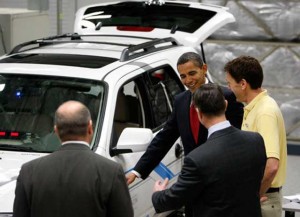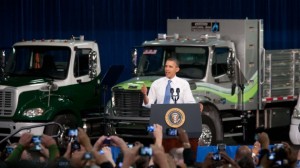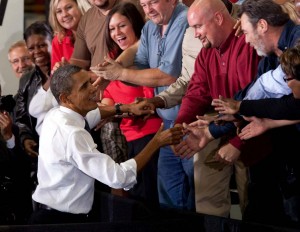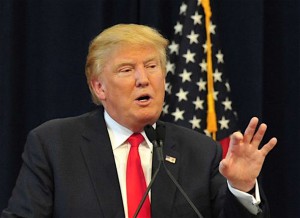
President Barack Obama's legacy as it relates to the auto industry will be largely considered positive, according to analysts.
As the new Trump Administration takes shape, auto industry leaders will be watching closely to see how it handles a wide range of issues, from fuel economy regulations to tariffs and trade. They’ll also be taking stock of what happened during the eight years when President Barack Obama was in the driver’s seat.
Few presidents since Franklin Delano Roosevelt, during the Great Depression, have been in power during a time of such mammoth change for this powerhouse industry. When he first entered the White House in January 2009, all three domestic automakers seemed ready to fail – two ultimately filing for bankruptcy before receiving massive bailouts. Today, the industry is, on the whole, turning record profits.
Obama’s tenure coincided with monumental transformation in an industry that, at one point directly or indirectly employed one in seven Americans. And, observers contend, many of those changes will continue to play out during the years and decades to come, including the emergence of autonomous vehicles and the rise of ride- and car-sharing.
The outgoing president has had praise for industry leaders, such as General Motors’ first female chief executive, Mary Barra, whom he spotlighted during his 2014 State-of-the-Union address. Having risen from a co-op student and factory floor worker, Obama said Barra’s rise illustrated, “the strength of our work ethic and the scope of our dreams.”
In turn, the president earned praise from a number of industry leaders. Asked to comment upon his legacy, Ford Motor Co. provided a statement noting how the President’s decision to provide mutli-billion-dollar bailouts for rivals GM and Chrysler “was the right thing to do for the country.”
(EPA finalizes 54.5 mpg standard before end of Obama’s term. For more, Click Here.)
The bailout was the first major decision President Obama had to make regarding the auto industry, and he justified expanding the program started by predecessor George W. Bush by declaring it would save as many as 1 million American jobs and keep the recession from turning into another depression.
Nonetheless, it remains one of the most controversial moves made during Obama’s eight years in office. There were other controversies, however, and a few failures:
* A loan program meant to encourage the development of high-efficiency vehicles and technology was scrapped after several high-profile failures, including the collapse of battery-carmaker Fisker Automotive;
* A program aimed at scrapping old, polluting vehicles and helping boost domestic manufacturer’s sales during the depth of the recession achieved only mixed success – and largely boosted demand for imports;
* And sales of plug-based vehicles, such as the Chevrolet Volt extended-range electric, fell far short of the president’s goal of 500,000.
That said, many industry analysts believe that EVs have reached critical mass, with the launch of new, lower-priced, higher-mileage models such as the Chevrolet Bolt EV and Tesla Model 3 during the final year of the Obama Administration.
(Click Here for the story about Obama upholding tougher CAFE standards.)
And development of autonomous vehicle technology, a prime goal of Obama’s Department of Transportation, has hit “an inflection point,” as well, according to John Krafcik, CEO of Waymo, the recently renamed Google self-driving car subsidiary. How it will play out will likely only come into shape under President Donald Trump and his own successors, but Mark Rosekind, the outgoing administrator of the National Highway Traffic Safety Administration, said there is now the very real possibility of reaching the point where there will be “zero deaths on American highways.”
Rosekind, who joined the administration halfway through its second term, has been widely hailed by industry leaders such as Joe Hinrichspresident of the Americas at Ford, for creating a much more “cooperative” approach to industry-government relations than had been the case in recent decades.
That was underscored when, in January 2016, a group of two dozen top industry executives came together at the Detroit Auto Show to announce the formation of a new consortium aimed at bringing breakthrough safety technology to market faster than would be possible through the traditional regulatory process.
On the other hand, the outgoing administration matched such carrots with big sticks. Enforcement of ethical and safety violations by the auto industry was perhaps more aggressive than ever. In just the final weeks of the administration, Volkswagen pleaded guilty in a criminal probe involving its diesel emissions scandal, paying $4.3 billion. Meanwhile six VW employees were indicted. Another three executives at Takata were charged in that automaker’s airbag scandal. And General Motors paid a $1 million fine to the SEC following its own ignition switch flap.
Another transformation that began under the Obama Administration is ride-sharing. Many believe that services like Lyft and Uber could lead to an era of significantly reduced vehicle ownership, especially if driverless vehicles make it even cheaper to hail a ride than keep a car parked in the garage.
But, for now, automakers can celebrate the fact that the finale for the Obama Administration was the third year in the row of record industry sales – and the second to top 17 million. That’s something of a mixed legacy to be leaving for new President Trump, as the general consensus is that new vehicles sales will slide this year. How much is a matter of debate and could depend upon implementation of trade and other economic policies.
A centerpiece of the Trump campaign was bringing back manufacturing jobs, with the threat of tariffs and other measures specifically targeting automakers like Ford. In recent weeks, a number of companies, including Ford, GM and Fiat Chrysler have announced moves that will add new jobs. But since reaching bottom in 2010 – with U.S. sales dropping below 10 million – those three makers alone have added close to 40,000 American jobs.
Foreign-owned makers like Toyota, Nissan and BMW have invested more than $20 billion in the country during the Obama era. New plants have or will open, including Volvo’s first American assembly line, going into South Carolina. And auto exports have risen sharply. More than half of the vehicles produced at the BMW plant in South Carolina now are shipped abroad.
“We were at rock bottom,” when Obama came into office, said analyst Dave Sullivan, of AutoPacific Inc. “The only place we could go was up.”
Sullivan gives the eight-year Obama run generally solid marks, though he sees a few missed opportunities. He says a true national energy policy that automakers can plan for remained elusive. And the administration failed to work out a plan with Europe, Japan and other key markets to commonize lighting, emissions and safety standards, something that could save automakers a lot of money.
Perhaps the biggest disappointment for the industry – but the biggest victory for environmentalists – was another late-in-term decision, the EPA this past week reaffirming the tough, 54.5 mpg fuel economy standards set to phase in through 2025.
Reversing that call is expected to be one of the first things automakers will seek from the new White House team.
(Change coming to auto industry. Click Here for more.)
But despite a few fumbles and missed passes, the overall legacy of the Obama Administration is a positive one, said analyst Sullivan, “I think we’ll look at this as a good time for the auto industry.”



